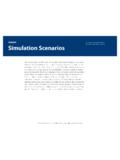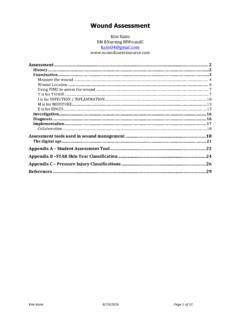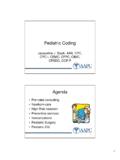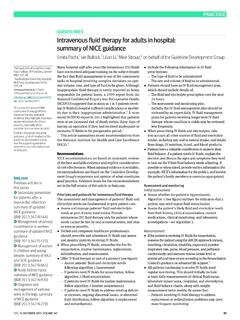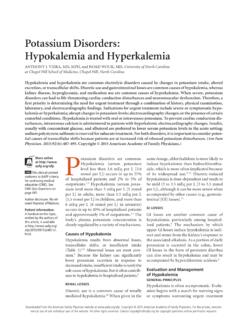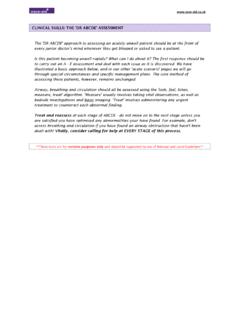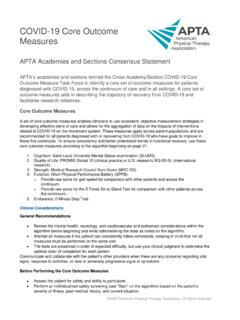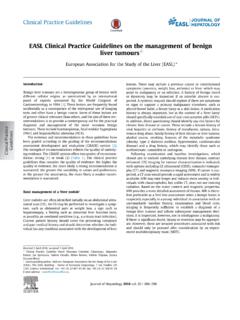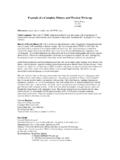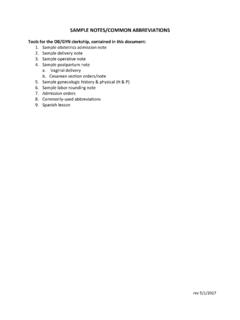Transcription of module Simulation Scenarios
1 ModuleSimulation ScenariosThis material is made available as part of the professional education programs of the American Academy of Pediatrics and the American College of Emergency Physicians. No endorsement of any product or service should be inferred or is intended. Every effort has been made to ensure that contributors to the APLS materials are knowledgeable authorities in their fields. Readers are nevertheless advised that the statements and opinions expressed are provided as guidelines and should not be construed as official policy of the American Academy of Pediatrics or the American College of Emergency Physicians. The recommendations in these accompanying materials do not indicate an exclusive course of treatment.
2 Variations, taking into account individual circumstances, nature of medical oversight, and local protocols, may be appropriate. The American Academy of Pediatrics, the American College of Emergency Physicians, and the authors here within disclaim any liability or responsibility for the consequences of any actions taken in reliance on these statements, opinions, or contents contained within these materials. 2015 by the American Academy of Pediatrics and the American College of Emergency PhysiciansmoduleSimulation ScenariosContentsAdrenal Insufficiency 1 Blunt Abdominal Trauma Hypovolemic Shock 4 Cardiogenic Shock Due to Congenital Heart Disease 8 Altered Mental Status 10 Diabetic Ketoacidosis and Cerebral Edema 12 Hyperthermia 15 Hypothermia Near Drowning 18 Iron Overdose 22 Myocarditis Cardiogenic Shock 25 Occult Trauma (Intentional Trauma)
3 27 Postoperative Cardiac Patient Ventricular Fibrillation 30 Septic Shock 33 Chest Crisis Sickle Cell Disease 36 Status Asthmaticus 39 Status Epilepticus 42 Stridor Due to Foreign Body 45 Supraventricular Tachycardia 48 Tricyclic Antidepressant Overdose 50 Metabolic Crisis Hyperammonemia 54 2015 by the American Academy of Pediatrics and the American College of Emergency Physicians1 Simulation Scenarios Adrenal InsufficiencyAdrenal InsufficiencyAdam Cheng, MD, FRCPC, FAAPMark Adler, MDLearning Objectives Describe the signs and symptoms of an infant presenting with salt-wasting adrenal crisis associated with congenital adrenal hyperplasia and adrenal insufficiency. Demonstrate the treatment of a newborn with salt-wasting crisis.
4 Initial stabilizing steps. Replacement : Infant SimulatorScenario StagePatient ConditionInterventionInstructor Debriefing Notes Time, minSTAGE 1 History Three-week-old boy with unremarkable history, referred to emergency department from physician s office with a low serum sodium level (126 mmol/L) Mother s pregnancy was normal; she recalls no abnormal test results Triage nurse was worried about how ill the child appears You arrive to assess the patientWeight: 3 kgCondition: Very unwell, listlessPhysical Examination Findings: Temperature C ( F), HR 152/min, RR 36/min, oxygen saturation 98% in room air, BP 72/58 mm Hg CNS: asleep, wakes briefly with painful stimulation CVS: pulses present centrally, absent peripherally Respiratory: clear Abdomen: no hepatosplenomegaly Extremities/skin: capillary refill >4 sTake a History.
5 No ill contacts No medications No allergies Poor feeding over last week, spitting up more in past few days No fever Sleeping through feeding time last few days, slept most of the last 12 h Has lost weight since last family physician visitAirway: Listen for breath sounds, present Apply oxygen via nonrebreather mask at 15 L/minBreathing: Apply monitors, including oxygen saturation and blood pressure Auscultate chest and observe respiratory rateCirculation: Assess pulse, HR, capillary refill, BP Ask nurse for an IV catheter to be placed Ask for normal saline or lactated Ringer solution bolus of 20 mL/kg to be given quickly (push)Medical Management: Order laboratory tests: (CBC, electrolytes, blood cultures, venous blood gas, bedside glucose)5 2015 by the American Academy of Pediatrics and the American College of Emergency Physicians2 Simulation Scenarios Adrenal InsufficiencyScenario StagePatient ConditionInterventionInstructor Debriefing Notes Time, minSTAGE 2 Condition: HR remains elevated and BP is now low Nurse notes aloud, His hands are just so cold.
6 Blood glucose level is low if bedside testing was performed Laboratory results: sodium 124 mmol/L, potassium mmol/L, bicarbonate 16 mmol/L, BUN and creatinine normal for age, pH from venous gas Examination Findings: HR 150/min, RR 36/min, oxygen saturation 99% on 100% oxygen (if placed), BP 73/60 mm Hg CNS: cries weakly with painful stimuli Respiratory: clear CVS: clamped down and cool extremities. Abdomen: no hepatosplenomegalyREASSESSMENT OF THE PATIENT:Circulation: Reassess HR, pulse, capillary refill, BP after bolus Order second bolus, also pushMedical Management: Consult endocrinologist for treatment guidance; order tests they might request Order IV hydrocortisone Order D10W IV bolus to correct hypoglycemia Initiate management of hyperkalemia5 STAGE 3 Condition: He is looking around more now.
7 Improved perfusion and alertness after second bolusPhysical Examination Findings: HR 138/min, RR 36/min, BP 78/48 mm Hg, saturation 98% on room air Abdomen: no hepatosplenomegalyREASSESSMENT OF THE PATIENT:Circulation: Reassess HR, pulse, capillary refill, BPMedical Management: Order recheck of electrolytes after bolus therapyDisposition: Arrange for neonatal or pediatric ICU for monitoring and frequent laboratory work until stabilized or plan for transport to tertiary care facility (depending on presenting facility resources)5 Abbreviations: BP, blood pressure; BUN, blood urea nitrogen; CBC, complete blood cell count; CNS, central nervous system; CVS, cardiovascular system; D10W, 10% dextrose in water; HR, heart rate; ICU, intensive care unit; IV, intravenous; RR, respiratory rate.
8 2015 by the American Academy of Pediatrics and the American College of Emergency Physicians3 Simulation Scenarios Adrenal InsufficiencyNotes1. Potassium and sodium derangements usually do not require short-term treatment beyond fluid resuscitation and Pitfalls Intravenous (IV) fluid for volume expansion is not delivered in a rapid and/or controlled manner. IV wide open fluid administration can lead to very rapid infusion of a whole liter of fluid OR can result in underresuscitation if there is significant re-sistance to flow (small IV gauge). Infants and small children should always receive resuscitation fluids using a pump or push to allow for observation and control of fluid delivery. Pressure bags can increase the likelihood of excessive fluid overload.
9 Pushing fluid is accomplished by attaching a three-way stopcock in line with the IV catheter and pulling fluid directly from the bag (step 1) and then switching the stopcock and pushing the fluid into the patient. Failing to check a bedside glucose level. Hypoglycemia is not always present in patients with congenital adrenal hyperplasia and salt-wasting crisis, but it can occur. Delaying treatment with hydrocortisone to obtain diagnostic tests. 2015 by the American Academy of Pediatrics and the American College of Emergency Physicians4 Simulation Scenarios Blunt Abdominal Trauma Hypovolemic ShockBlunt Abdominal Trauma Hypovolemic ShockAdam Cheng, MD, FRCPC, FAAPMark Adler, MDLearning Objectives Describe the signs and symptoms of a patient with hypovolemic shock.
10 Demonstrate the management of circulatory failure due to hypovolemic shock. Demonstrate the approach to pediatric trauma: primary and secondary assessment . Demonstrate use of fluid resuscitation in patients with profound blood loss. Identify and manage abdominal injury in a trauma patient. Demonstrate use of rapid infuser in trauma : Pediatric SimulatorScenario StagePatient ConditionInterventionInstructor Debriefing Notes Time, minSTAGE 1 History: Five-year-old boy Playing in the driveway Found by parents crushed and trapped underneath garage door Garage door directly over his abdomen No witnesses to the incident Ambulance arrived within 12 minWeight: 18 kgCondition: Moaning in pain Temperature 36 C ( F), HR 150/min, RR 30/min, BP 85/50 mm Hg, oxygen saturation 96% room air Monitor: sinus tachycardia CNS: cervical collar on patient; moaning in pain, answers questions, asking for mom, confused at times, GCS score of 15.
